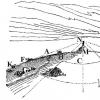Wealth given to people Pavel Stepanovich Nakhimov. Nakhimov, Pavel Stepanovich. Biography of the admiral. Further naval service
160 years ago, on July 12, 1855, Admiral Pavel Stepanovich Nakhimov died. The great Russian man fell heroically defending Sevastopol. Admiral Pavel Stepanovich Nakhimov occupies one of the most honorable places among the national heroes of the Russian people. He went down in Russian history as an outstanding naval commander, a worthy successor to the Russian glorious traditions of F.F. Ushakova, D.N. Senyavin and M.P. Lazarev and the hero of the defense of Sevastopol during the Eastern (Crimean) War. Then the united forces of Western civilization again came out against Russia, but all of their aggressive and predatory plans were thwarted by the heroic defense of Sevastopol.
From the biography
Pavel Stepanovich was born on June 23 (July 5), 1802 in the village of Gorodok, Vyazemsky district, Smolensk province. His father was a poor nobleman, Second Major Stepan Mikhailovich Nakhimov. Mother - Feodosia Ivanovna (nee Kozlovskaya). In 1818, he successfully graduated from the Naval Cadet Corps and was enlisted as a midshipman in the 2nd naval crew.
Already during his studies, as the famous Russian historian E.V. Tarle correctly noted, a curious character trait of Nakhimov was discovered, which was immediately noticed by his comrades, and then by colleagues and subordinates: “He did not know and did not want to know any life other than naval service.” he simply refused to admit to himself the possibility of existing not on a warship or in a military port. Due to lack of leisure and too much preoccupation with maritime interests, he forgot to fall in love, forgot to get married. He was a nautical fanatic, according to the unanimous opinion of eyewitnesses and observers.” In this, Nakhimov was like his glorious predecessor F.F. Ushakov.
Served in the Baltic Fleet. In his certification it was noted: “he is diligent and knowledgeable in his service; noble behavior, diligent in office”; “He performs his duties with zeal and efficiency.” He completed a three-year circumnavigation of the world (1822-1825) as a watch officer on the frigate “Cruiser” under the command of M.P. Lazarev. Lazarev quickly appreciated the abilities of the young and intelligent officer and became so attached to him that from that time on they practically never separated in their service. During the voyage, Pavel was promoted to lieutenant and received his first Order of St. Vladimir, 4th degree.
After returning from the voyage, Pavel became the battery commander on the battleship Azov, commanded by Lazarev. On this ship in the summer of 1827, he took part in the passage from the Baltic Sea to the Mediterranean, where he took part in hostilities against the Ottomans. He distinguished himself in the Battle of Navarino, where the combined fleet of Russia, France and England defeated the Turkish-Egyptian fleet. The flagship Azov, under the command of Lazarev, fought the best, destroying 5 Turkish ships, including the frigate of the commander of the Turkish fleet. Pavel was awarded the Order of St. George IV class and promoted to captain-lieutenant. An interesting fact is that in this battle on “Azov” all the future heroes of the defense of Sevastopol distinguished themselves - P. S. Nakhimov, V. A. Kornilov and V. I. Istomin.
In 1828, 24-year-old Nakhimov was the commander of the 16-gun corvette Navarin (Turkish “prize”). Nakhimov made the corvette a model ship for the squadron. The corvette took part in the blockade of the Dardanelles. Admiral Lazarev noted the young commander and, certifying him, noted that he was “an excellent and completely knowledgeable sea captain.” From 1830, having returned to the Baltic, he commanded the Navarin, and from 1831, the 52-gun frigate Pallada.
In 1834, at the request of Lazarev, who was then commander of the Black Sea Fleet, Nakhimov was transferred from the Baltic to the Black Sea. In 1836, Nakhimov received under his command the 84-gun battleship Silistria, which was built under his supervision. Nakhimov commanded this ship for 11 years, making Silistria an exemplary ship. His name became popular in the Black Sea Fleet. His colleagues respected him as a brilliant sailor, and the sailors called him “father.” In 1837 he was promoted to captain of the first rank. On the Silistria, Captain 1st Rank Nakhimov performed cruising voyages in the Black Sea and participated in the transportation of ground forces to the Black Sea shores of the Caucasus. The ship took part in 1840 in landing operations on the Caucasian coast.
In 1845, Nakhimov was promoted to rear admiral and appointed commander of a brigade of ships. Pavel Stepanovich became one of Admiral Lazarev's closest assistants in strengthening the Black Sea Fleet and increasing its combat effectiveness. Nakhimov continued and developed the traditions of Ushakov, Senyavin and Lazarev. People noted that it “serves 24 hours a day.” Demanding a lot from others, Pavel Stepanovich did not spare himself at all, showing the highest responsibility. Demanding demands on his subordinates were combined with concern for the sailors. He went into the smallest details of their lives, helped in word and deed, and saw ordinary sailors as people, not serfs. Pavel Stepanovich was a man with a capital M, ready to give his last penny to a person in need, to help an old man, woman or child. He did not have an extra ruble, giving every last bit to the sailors and their families.
Nakhimov demanded that officers treat their sailors humanely. He repeatedly repeated that the decisive role in battle belongs to the sailor. “It’s time for us to stop considering ourselves landowners,” said the Russian admiral, “and sailors as serfs. The sailor is the main engine on a warship, and we are only the springs that act on him. The sailor controls the sails, he also points the guns at the enemy; a sailor will rush to board if he does not look at service as a means to satisfy his ambition, and at his subordinates as a step for his own elevation. These are the ones we need to elevate, teach, arouse in them courage, heroism, if we are not selfish, but truly servants of the Fatherland...”
Lazarev and Nakhimov, like Kornilov and Istomin, were representatives of a school that demanded spiritual heights from an officer. They were opposed to laziness, drunkenness, gambling and all sybaritism among the command staff. They fought in every possible way against the “naval landowners,” who tried not to bother themselves too much with their affairs in the naval service. At the same time, Nakhimov very perspicaciously noted a trait of a significant part of the Russian upper class: “Many young officers surprise me: they lagged behind the Russians, did not stick to the French, and are also not like the British; They neglect their own, envy others, and do not understand their own benefits at all. This is no good!”
As a result, Nakhimov had a huge influence on the development of the Black Sea Fleet. His intelligence and exactingness strengthened the command staff. The sailors loved him, he spoke to them in their language. The devotion and love of the sailors for him reached unprecedented heights, which was perfectly demonstrated during the heroic defense of Sevastopol. Thus, Nakhimov’s daily appearance on the bastions of Sevastopol aroused incredible enthusiasm among the defenders. Tired, exhausted sailors and soldiers literally resurrected and were ready to repeat miracles. It was not for nothing that the admiral himself said that with our dashing people, by showing attention and love, you can do such things that are simply a miracle.
In the development of naval tactics, Nakhimov was a staunch supporter of decisive, attacking actions. In 1852, Nakhimov was promoted to vice admiral and appointed head of the 5th naval division. On the eve of the war with Turkey, Nakhimov's squadron, at the end of September - beginning of October 1853, carried out the transfer of the 13th Infantry Division from Sevastopol to Anakria within a week. This strengthened the defense of the Caucasus.
To prevent the landing of enemy troops, Nakhimov organized cruising from the Bosphorus to Batumi. Cruising took place along the Anatolian coast of the Ottoman Empire. October 4 (16), 1853 Porta declared war on Russia and began hostilities. Another Russian-Turkish war began, which soon grew into a war between Russia and a coalition of the strongest European powers. In this war, Nakhimov’s naval art and Russian spirit were fully demonstrated.
Having received news of the start of hostilities, Nakhimov immediately announced this to the squadron and gave an order, ending with the words: “I notify the commanders that, in the event of meeting an enemy superior to us in strength, I will attack him, being absolutely sure that each of us will do its job." In another order, Nakhimov noted: “With confidence in my commanders and officers and teams, I hope to accept the battle with honor... Without expanding into instructions, I will express my thought that, in my opinion, in naval affairs there is close distance from the enemy and mutual assistance each other has the best tactics.”
On November 18 (30), 1853, Nakhimov’s squadron destroyed the Turkish fleet in the Battle of Sinop (Battle of Sinop November 18 (30), 1853). Contemporaries highly appreciated the feat of the Russian sailors and their leader. The Russian emperor highly appreciated Nakhimov's victory. Admiral Nakhimov was granted the highest rescript from Nicholas I, which said: “By the extermination of the Turkish squadron at Sinop, you adorned the chronicle of the Russian fleet with a new victory, which will forever remain memorable in naval history. Fulfilling with true joy the decree of the statute, we grant you the Knight of St. George, II degree of the Grand Cross.”
Turkey's naval power was undermined. Nakhimov was pleased with the military results of the battle. The Black Sea Fleet brilliantly solved its main task: it eliminated the possibility of a Turkish landing on the coast of the Russian Caucasus and destroyed the Ottoman squadron, gaining complete dominance in the Black Sea. Enormous success was achieved with little blood and material losses. After a difficult search, battle and passage across the sea, all Russian ships successfully returned to Sevastopol. Nakhimov was pleased with the sailors and commanders; they held up superbly in the fierce battle.
However, Nakhimov was concerned about the political effect of the operation. He feared that the Sinop victory would cause the appearance of Anglo-French forces on the Black Sea, which would use all their might to destroy the combat-ready Black Sea Fleet. He had a presentiment that the real war was just beginning.
The West began to fear that Russia was implementing Catherine the Great’s plan to capture the straits and Constantinople. Russia's victory over Turkey opened up attractive geopolitical prospects in the Balkans, Mediterranean and Middle East. Russia was becoming a superpower. In order to prevent the complete defeat of Turkey, in March 1854 England and France declared war on Russia and sided with the Ottoman Empire. A wave of Russophobia is rising in Western Europe. Russian victories caused fear and hatred. Russia was shown as a huge giant who wants to crush the “unfortunate” Turkey. They say that “civilized Europe” must resist “Russian aggression”.
Heroic defense of Sevastopol
In 1854, the main efforts of the Anglo-French command were concentrated in the Black Sea region. The Western powers wanted to deprive Russia of its conquests in the Black Sea region and the Baltic states. The main blow was delivered in Crimea. The allies' attention was drawn to the main base of the Black Sea Fleet - Sevastopol. In September 1854, a huge Anglo-French-Turkish fleet landed an expeditionary army in the Evpatoria region.
The Russian army, inferior in number to the enemy, under the command of Prince A.S. Menshikova was defeated at the river in September. Alma then went first to Sevastopol. But then, fearing that the enemy would block and destroy his army, which would lead to the fall of Crimea, and also in order to maintain the possibility of maneuver, Menshikov left Sevastopol.
At this critical moment, the defense of the city was led by Kornilov and Nakhimov. The two admirals became the soul of the city's defense. Pavel Stepanovich was a kind of “hero admiral”, more of a brilliant naval commander than an economic manager, and Kornilov showed more administrative abilities for organizing the economy. Therefore, Nakhimov, although he had seniority in service, without the slightest hesitation in these terrible days, transferred the issues of organizing defense to Kornilov, helping him in every possible way. Sevastopol had ships and coastal batteries for defense from the sea, but the city was extremely poorly defended from land. The city was not fortified before the war. Therefore, sailors and soldiers under the command of Kornilov, Nakhimov and Totleben had to do titanic work to create a strong defense of Sevastopol. They did everything possible and impossible to prepare the city for a difficult fight. They worked day and night.
As a result, when the Allies approached Sevastopol, where previously there were only separate fortifications, not connected to each other and having large, almost unprotected gaps, a continuous defensive line was equipped. New artillery positions, dugouts, shelters and communication lines were erected. It turned out that the Anglo-French command missed the moment for an open assault on Sevastopol, and was forced to begin siege work. Instead of a quick victory, the Allies were forced to spend time and all their strength fighting the garrison of Sevastopol. The 349-day defense of Sevastopol captured all the attention and forces of the allies, which allowed Russia to exit the war without much loss.
After Kornilov died during the first bombardment of the city on October 5 (17), 1854, Pavel Stepanovich Nakhimov almost completely took over his mission. Formally, the defense of the city was commanded by the head of the Sevastopol garrison, General Osten-Sacken, but in fact Nakhimov led the defense of Sevastopol. In February 1855, Nakhimov was officially appointed commander of the Sevastopol port and military governor of the city. On March 27 (April 8) he was promoted to admiral.
Pavel Nakhimov correctly assessed the strategic importance of the defense of the Sevastopol fortress as the main base of the Black Sea Fleet. “Having Sevastopol,” the admiral wrote, “we will have a fleet..., and without Sevastopol it is impossible to have a fleet on the Black Sea: this axiom clearly proves the need to decide on all sorts of measures to block the entrance of enemy ships to the roadstead and thereby save Sevastopol.”
On June 6 (18), 1855, another attack began. The fiercest battles took place on Malakhov Kurgan. Russian troops repelled the assault on Sevastopol. Joy swept the city and all of Russia, the opponents were greatly depressed. However, June 1855 brought the defenders of Sevastopol not only the joy of victory, but also two misfortunes. Totleben was seriously wounded and taken away from Sevastopol. Everyone was afraid that the brilliant military engineer would die, but fate preserved him. The defenders of the fortress were in for an even more crushing blow.
Nakhimov miraculously survived the assault on June 6 (18). During the battle, he was in the most dangerous place - on the Malakhov Kurgan. When the French again broke through to the positions, many commanders had fallen, soldiers huddled together, Nakhimov and his two adjutants commanded: “With bayonets!” and the Russian soldiers cheered up and knocked out the enemy. As a result, on this day Nakhimov completed the work of saving the Malakhov Kurgan, begun by Khrulev.
It should be noted that, apparently, Nakhimov understood the doom of Sevastopol. He constantly took risks. One of Nakhimov’s bravest associates in the defense of Sevastopol, Prince V.I. Vasilchikov (Nakhimov himself said: “Take care of Totleben, there is no one to replace him, but I, sir!” “It doesn’t matter how they kill you or me, but it will be a pity , if something happens to Totleben or Vasilchikov!”), who had been observing the admiral for a long time, noted: “There is no doubt that Pavel Stepanovich did not want to survive the fall of Sevastopol. Remaining one of the associates of the former valor of the fleet, he sought death and recently began, more than ever, to exhibit himself at banquets, on the towers of bastions, attracting the attention of the French and English riflemen with his numerous retinue and the shine of his epaulettes...”
More than once Nakhimov was literally taken by force from the front line. So, on the Kamchatka lunette, before his fall, in the end, the sailors, without asking, grabbed Nakhimov and carried him out in their arms, because he hesitated and after a few seconds they would have killed him or would have captured him. The admiral usually left his retinue behind the parapet, and he himself went out to a prominent place and stood there for a long time, looking at the enemy batteries, “waiting for lead,” as the same Vasilchikov put it.
When one of the sailors, tired and exhausted, asked to rest, Nakhimov raised his morale with these words: “What, sir! Do you want to resign from your post? You must die here, you are a sentry, sir, there is no shift for you, sir, and there will never be one! We're all going to die here; remember that you are a Black Sea sailor, sir, and that you are defending your native city! We will give the enemy only our corpses and ruins, we cannot leave here, sir! I have already chosen my grave, my grave is already ready, sir! I will lie down next to my boss, Mikhail Petrovich Lazarev, and Kornilov and Istomin are already lying there: they have fulfilled their duty, we need to fulfill it too!”
On June 28 (July 10), at 4 a.m., the enemy began a fierce shelling of the 3rd bastion. Nakhimov rode on horseback with two adjutants to inspect the 3rd and 4th bastions to support their defenders. Arriving at Malakhov Kurgan, he watched the progress of the battle through a telescope and encouraged the soldiers and commanders. As usual, Nakhimov did not heed any warning. And this time everything ended badly.
Several bullets passed near the admiral. “They shoot quite accurately today,” said Nakhimov, and at that moment another shot rang out. Nakhimov fell to the ground without a single groan, as if knocked down. The bullet hit the face, pierced the skull and exited at the back of the head. Without regaining consciousness, Nakhimov died two days later. Sevastopol lost the “soul of defense,” and the Russian people lost one of their most glorious sons.
Alexander Samsonov
24.10.2017
Admiral P.S. Nakhimov became a legendary figure during his lifetime. Having devoted himself entirely to serving Russia, he seemed to have no other desires than to increase the military power of his homeland and strengthen its navy. Let's get acquainted with several interesting facts from the life of the famous admiral Pavel Stepanovich Nakhimov.
- Pavel Nakhimov was born in the village of Gorodok, Smolensk province. This happened on July 5, 1802. The family of retired military man Nakhimov quickly grew: there were 11 children in total.
- Five brothers, including Pavel, followed in their father’s footsteps, choosing a military career. Pavel graduated from the Naval Cadet Corps, and was sixth on the list in terms of academic performance: he was an excellent student. Interestingly, his younger brother Sergei later became the head of this educational institution.
- At the age of 15, Pavel received the rank of midshipman. Soon he sets off on a three-year voyage around the world on the ship “Cruiser” under the command of M.P. Lazarev. Lazarev was a talented leader, well versed in all the intricacies of tactics and strategy for naval combat, was an excellent psychologist and had great influence on his subordinates. For young Pavel, he became a second father. The young man quickly adopted the experience of his older comrade.
- The future admiral had to endure many battles on the Black Sea. But his military operations include not only naval battles. Just before the Crimean War, he brilliantly carried out an operation to transfer troops to the Caucasus from the Crimean Peninsula (3 infantry divisions were transferred).
- One of the main battles that made Nakhimov famous was the Battle of Sinop Bay. Nakhimov managed to destroy the enemy, despite the fact that he had half the strength of the enemy. At the same time, Nakhimov did not lose a single ship.
- Pavel Nakhimov selflessly served Russia. According to eyewitnesses, he could not imagine life on the shore. There the famous naval commander had neither friendly affections nor real business. They said about him that he did not have time to fall in love or get married.
- Nakhimov received the rank of full admiral a few months before his death, in March 1855.
- Nakhimov’s wallet was always open to distressed sailors who had retired or were written off due to health reasons, and their families. Witnesses described the following scenes: in Sevastopol, the admiral went out onto the pier, and was immediately surrounded by a crowd of people in need. He listened to complaints and requests, and immediately gave orders to his subordinates: to help this old man with the construction of a house, to give that old woman 5 rubles, to issue financial assistance to the widow and children of the deceased sailor. Most often, the money for this came directly from Nakhimov’s personal funds.
- When the Crimean War of 1853-56 broke out, Nakhimov was appointed to command the defense of Sevastopol along with Kornilov and Istomin. After Kornilov died, Istomin and Nakhimov held the defense together.
- Sending messages to the government that Sevastopol would remain ours, Nakhimov already knew: the city could not be defended. He was sure that death would find him here. Indeed, Nakhimov no longer saw the moment of the surrender of Sevastopol.
- The admiral moved boldly under bullets and often went to the front line. On a fateful day for himself, Nakhimov, neglecting the danger and attempts of his subordinates to take him away from the battlefield, climbed the Malakhov Kurgan: he needed to see the whole picture of the battle. One stray bullet hit the brave military leader in the temple. Two days later, the admiral died without regaining consciousness.
The valiant Admiral Nakhimov was 53 years old at the time of his death. How often does Russia lose its true heroes at an age when they could have accomplished much more!..
Nakhimov in the Crimean War
June 1855 brought the defenders of Sevastopol not only the joy of victory, but also two misfortunes. Shell-shocked on the day of the assault, Totleben was ill and did not want to go to bed. Two days later, on June 8 (20), while inspecting the Gervais battery, he was very seriously wounded and was taken away from Sevastopol.
They were afraid of Totleben's death. But fate preserved him for new brilliant achievements, for the capture of Plevna in 1877, and for the black year in his biography, about which one can only repeat the words of V.G. Korolenko: “In 1879-80, the famous military engineer and strategist Totleben was governor-general in Odessa. Evil Russian fate wished that this general end his brilliant reputation as a warrior with far from brilliant administrative activities. The famous general was ruled by the notorious Panyutin, at whose suggestion, although under the moral responsibility of the general himself, a memorable orgy of administrative exile began in Odessa. It was too late, just leaving Odessa, Totleben realized in whose hands he was a tool, and with despair and rage he publicly attacked the vile man who had disgraced his gray hair...”
But in June 1855, when the seriously wounded Totleben was taken away from Sevastopol, his young glory was still bright and untarnished, and the sorrow of the defenders of the fortress was great. An even more crushing blow awaited them that same month.
Nakhimov Pavel Stepanovich (1802–1855), Russian naval commander, hero of the Sevastopol defense.
Before the Crimean War of 1853–1856, already being the commander of the 1st Black Sea Squadron, in September 1853 he carried out the operational transfer of the 3rd Infantry Division from Crimea to the Caucasus. With the outbreak of hostilities in October 1853, she cruised off the coast of Asia Minor. On November 18 (30), without waiting for the approach of the detachment of steam frigates V.A. Kornilov, he attacked and destroyed the twice superior forces of the Turkish fleet in Sinop Bay, without losing a single ship (the last battle in the history of the Russian sailing fleet); awarded the Order of St. George, 2nd degree. In December he was appointed commander of the squadron that defended the Sevastopol raid. After the landing of the Anglo-French-Turkish squadron in the Crimea on September 2–6 (14–18), 1854, together with V.A. Kornilov, he led the preparation of Sevastopol for defense; formed battalions from coastal and naval commands; was forced to agree to the sinking of part of the sailing ships of the Black Sea Fleet in the Sevastopol Bay. On September 11 (23), he was appointed chief of defense of the South Side, becoming the main assistant to V.A. Kornilov.
Successfully repelled the first assault on the city on October 5 (17). After the death of V.A. Kornilov, he headed, together with V.I. Istomin and E.I. Totleben, the entire defense of Sevastopol. February 25 (March 9), 1855 appointed commander of the Sevastopol port and temporary military governor of the city; in March he was promoted to admiral.
Under his leadership, Sevastopol heroically repelled Allied attacks for nine months. Thanks to his energy, the defense acquired an active character: he organized sorties, waged counter-battery and mine warfare, erected new fortifications, mobilized the civilian population to defend the city, and personally toured forward positions, inspiring the troops. Awarded the Order of the White Eagle.
On June 28 (July 10), 1855, he was mortally wounded by a bullet in the temple on the Kornilovsky bastion of the Malakhov Kurgan. He died on June 30 (July 12) without regaining consciousness. The death of P.S. Nakhimov predetermined the imminent fall of Sevastopol.
The famous Russian admiral Pavel Stepanovich Nakhimov was born on June 23, 1802 in the village of Gorodok, Smolensk province. It is 260 km from Moscow. He died on June 30, 1855 at the age of 53 in the city of Sevastopol. A nobleman by birth. He served in military service since 1818 after graduating from the Naval Cadet Corps in St. Petersburg. In 1817, as a midshipman, he made his first sea voyage in the Baltic Sea on the brig Phoenix.
Beginning of a military naval career
A true baptism of fire was the circumnavigation of the world in 1822-1825 on the 36-gun frigate "Cruiser" under the command of Mikhail Petrovich Lazarev (1788-1851). The expedition's goal was to protect Russian America from American smugglers. But where is Alaska and where is Kronstadt? Therefore, we had to go around the entire globe to get to our destination.
The ship crossed the Atlantic, circled South America, sailed to Tahiti, and from there headed north. For a year, the "Cruiser" guarded Russian waters from smugglers, and in October 1824 it was replaced by another ship. At the beginning of August 1825, the frigate returned to the Kronstadt port. It should be noted that the voyage took place in difficult conditions. It was accompanied by storms and hurricanes. All participants in this expedition were nominated for awards. Pavel Stepanovich received the rank of lieutenant.
Further naval service
The young officer's further service took place under the command of M.P. Lazarev on the battleship Azov. On October 8, 1827, he took part in naval battle of Navarino. Two fleets fought in this historical battle. On one side was the combined squadron of Russia, France and England, and on the other side was the Turkish-Egyptian fleet. The battle took place in the Bay of Navarino on the southwestern tip of the Peloponnese. The reason for it was the national liberation movement of the Greek people against the Turkish invaders.
The Turks suffered a crushing defeat, and the battery commander Nakhimov was awarded the next military rank of captain-lieutenant. For his courage and heroism, the young officer was awarded the Order of St. George, IV degree. The following year, Pavel Stepanovich was entrusted with command of the 3-masted warship Navarin. It was armed with 30 small and medium caliber guns.
During the Russian-Turkish War of 1828-1829, this corvette took part in blocking the Dardanelles Strait. And after the end of hostilities, the lieutenant commander was transferred along with the ship to the Baltic Fleet. In 1831, Pavel Stepanovich received under his command the most modern warship - the frigate Pallada.
The ship was built according to the personal highest order of Emperor Nicholas I. It was a masterpiece of military shipbuilding of those years. The ship had many design innovations, and was armed with 52 guns. Naturally, they entrusted their command to one of the most worthy officers of the naval fleet of the Russian Empire.
In 1834, Nakhimov was transferred to serve in the Black Sea Fleet. He became the commander of the 84-gun battleship Silistria. It was a real floating fortress. She was considered the best warship and flagship of the Black Sea Fleet.
In 1845, Pavel Stepanovich was awarded the military rank of rear admiral. He led a brigade of ships. And in 1852 he received the rank of vice admiral and became the head of the entire fleet.
Crimean War
In 1853, the Crimean War (1853-1856) began. During this harsh time for Russia, Admiral Nakhimov took charge of the Black Sea squadron. He once again glorified his name in Battle of Sinop. This battle took place on November 18, 1853. In fact, it became the first major battle of the Crimean War.
The battle took place in heavy rain and gusty winds. The Turkish ships were in the bay under the protection of coastal batteries. But this did not frighten the Russian sailors. Enemy resistance was suppressed by powerful gun fire. He destroyed Turkish ships and coastal batteries. Only one Turkish frigate Taif survived. He managed to escape from the fire and go to the open sea. All other ships were sunk. The commander of the Turkish squadron was captured.
In this battle, on the Russian side, 6 battleships and 5 frigates with a total of 746 guns took part. The Turks had 8 frigates and 4 corvettes with a total of 472 guns. Plus, 6 coastal batteries.
The news of the defeat of the enemy instantly reached Sevastopol. On November 22, the victorious ships entered the Sevastopol port amid general popular rejoicing. For the victory at Sinop, the sovereign awarded Pavel Stepanovich the Order of St. George, II degree.
The further course of hostilities was such that in February 1855, ships had to be sunk. Nakhimov was entrusted with the defense of the southern regions of Sevastopol. He proved himself to be a courageous defender and leader of the defense. At the same time, contemporaries noted that the soldiers and sailors treated the admiral with great warmth and respect.

Monument to Admiral Nakhimov in Sevastopol
Death
On June 28, 1855, Pavel Stepanovich toured the advanced fortifications in the most important military strategic sector - Malakhov Kurgan. The Anglo-French artillery fired continuously along the heights. One of the fragments of the exploding shell hit the commander's head. It is noteworthy that he, mortally wounded, was carried out from under fire by the deputy battery commander Vasily Ivanovich Kolchak (1837-1913) - the father of Alexander Vasilyevich Kolchak: the Supreme Ruler of Russia during the Civil War.
On June 30, 1855, Pavel Stepanovich died. He was buried in the city of Sevastopol in the Cathedral of St. Equal to the Apostles Prince Vladimir. Nowadays, this is Suvorov Street 3. During the funeral of the naval commander, the flags on the French and English military ships were flown at half-mast. Even the enemy paid tribute to this courageous man who selflessly served his homeland.
The image of an outstanding naval commander and a faithful son of Russia remained forever in the memory of the Russian people. Ships, lakes, settlements, and city streets are named after him. In 1943, by decree of the Council of People's Commissars of the USSR, the Nakhimov Naval School was created. Thousands of young men came out of its walls and continued the work to which the legendary admiral devoted his entire life.
Alexander Arsentiev


















